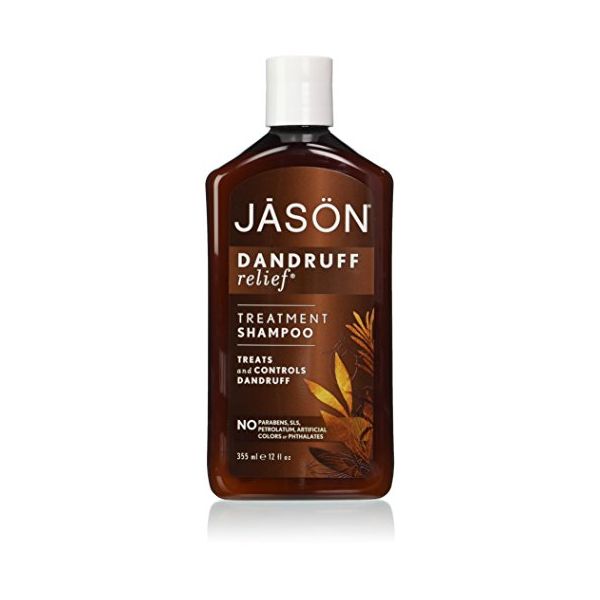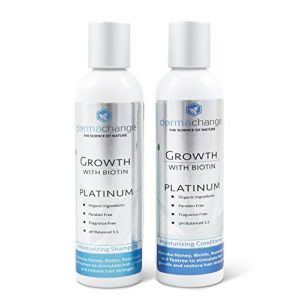- Pros:
- Medicated, FDA approved dandruff-controlling shampoo with sulfur, salicylic acid, olive, jojoba, and rosemary oils
- Helps fight seborrheic dermatitis and mild psoriasis
- Controls recurring flaking, scaling, itching, and irritation associated with dandruff
- Gently cleanses and nourishes hair
- Extra mild formulation soothes, heals, and moisturizes the scalp
- Certified by the CCIC
- Non-GMO
- Paraben-free
- Sulfate-free
- Petrolatum-free
- Phthalate-free
- Cruelty-free
- Free of artificial colors
Ingredients Concern: Salicylic acid, cocamidopropyl betaine, methyl salicylate, alcohol^(1)
Cons: Avoid contact with eyes, Rinse eyes thoroughly with water in case contact occurs, Discontinue use and consult your physician if irritation develops, Keep out of the reach of children, If swallowed, get medical help or contact a Poison Control Center right away
In 1959, a group of Californians got tired of seeing harsh chemicals in the products they were using manufactured by big companies. They decided to focus on making body loving products with plant based ingredients and using the restorative power of nature's botanicals. Jason which is the Greek word for heale was deemed the name of the company. They then set a code of honor to include 1) Safe, gentle and effective ingredients, 2) Never testing on animals and 3) innovating and improving constantly. You won't find parabens, phthalates, harsh sulfates or artificial colors in their skin, body and haircare products.
Salicylic acid targets clogged pores, promotes the shedding of dead skin cells, and improves the health of the skin, including the scalp [1]. Rosemary oil targets a substance that is associated with hair loss known as dihydrotestosterone (DHT) [2]. Jojoba oil helps loosen and promote the removal of sebum from the scalp, which is a thick substance that is linked to hair loss in some individuals [3]. Olive Oil is a rich source of monounsaturated fats (about 73%), followed by saturated fat (about 14%), and polyunsaturated fat (11%) [4-7]. Monounsaturated fats in olive oil enhance overall health [4-7]. Olive oil contains vitamins E, K, and an ample amount of antioxidants; it improves the body's utilization of vitamins A, D and K as well [8, 9]. All of these vitamins and nutrients help nourish the skin and hair. It also has anti-inflammatory properties that can help improve the health of the skin, including the scalp [10, 11].
Restores hair strength [1-4]; Lesses thinning hair [2]; Targets scalp irritation [2]
Salicylic acid has comedolytic properties that make it a helpful peeling agent that targets photodamage that can damage the scalp and hair follicles [1]. A hormonal imbalance may cause certain enzymes such as 5-alpha-reductase may begin to convert testosterone in both men and women into a stronger substance called dihydrotestosterone (DHT). Increased DHT levels leads to the accumulation of a thick, dandruff-like substance called sebum. Sebum can clog the roots of the scalp, which can subsequently disrupt nutrient transport to the scalp and hair follicles, hair loss. Rosemary oil blocks DHT activity, thereby preventing the buildup of sebum and hair loss [2]. Jojoba oil mimics the texture of sebum and this reduces the production of sebum on the scalp [3].
Olive oil contains a small percentage of polyunsaturated fat (e.g., omega-6 and omega-3 fatty acids) as well as a large percentage of monounsaturated fat called oleic acid, which helps target inflammation, improves heart health and may also have anti-cancer properties [4-7]. The body cannot produce these types of essential acids on its own. Olive oil contains vitamins and antioxidants that improve the body's ability to ward off illnesses [8, 9]. These nutrients help boost the health of the skin and hair. Olive oil contains anti-inflammatory components such as oleocanthal, which help improve the appearance of the skin and can also help target an irritated scalp [10, 11].
Key Ingredients: Salicylic acid 2.2%, Sulfur 2.4%
All Ingredients: Salicylic acid, Sulfur, Aqua (water), potassium cocoyl glutamate, sodium cocoyl isethionate, cetyl alcohol, disodium cocoamphodiacetate, cocamidopropyl betaine, stearic acid, glycerin, glyceryl stearate se, sodium laurylglucosides hydroxypropylsulfonate, olea europaea (olive) fruit oil^(1), rosmarinus officinalis (rosemary) leaf oil, simmondsia chinensis (jojoba) seed oil^(1), chenopodium quinoa seed^(1), alcohol^(1), camphor, capryloyl glycine, disodium cocoyl glutamate, menthol, methyl salicylate, potassium hydroxide, sodium chloride, sodium pca, triethyl citrate, undecylenoyl glycine, xanthan gum, benzyl alcohol, linalool
For best results, use at least three times each week. Wet hair and lather, massage onto scalp. Rinse and repeat if desired.
Store between 40 to 100 degrees F (4 to 38 degrees C).
These statements have not been evaluated by the FDA. These products are not intended to diagnose, treat, cure or prevent any disease.
1. Arif T. Salicylic acid as a peeling agent: a comprehensive review. Clin Cosmet Investig Dermatol. 2015;8:455-61.
2. Panahi Y, et al. Rosemary oil vs minoxidil 2% for the treatment of androgenetic alopecia: A randomized comparative trial. Skinmed. 2015;13(1):15-21.
3. Sandha GK, Swami VK. Jojoba oil as an organic, shelf stable standard oil-phase base for cosmetic industry.2009;2(2):300-306.
4. Basu A, Devaraj S, Jialal I. Dietary factors that promote or retard inflammation. Arterioscler Thromb Vasc Biol. 2006;26(5):995-1001.
5. Yoneyama S, Miura K, et al. Dietary intake of fatty acids and serum C-reactive protein in Japanese. J Epidemiol. 2007;17(3):86-92.
6. Menendez JA, Vellon L, Colomer R, Lupu R. Oleic acid, the main monounsaturated fatty acid of olive oil, suppresses Her-2/neu (erbB-2) expression and synergistically enhances the growth inhibitory effects of trastuzumab (Herceptin) in breast cancer cells with Her-2/neu oncogene amplification. Ann Oncol. 2005;16(3):359-71.
7. Menendez JA, Lupu R. Mediterranean dietary traditions for the molecular treatment of human cancer: anti-oncogenic actions of the main olive oil's monounsaturated fatty acid oleic acid (18:1n-9). Curr Pharm Biotechnol. 2006;7(6):495-502.
8. Tripoli E, Giammanco M, et al. The phenolic compounds of olive oil: structure, biological activity and beneficial effects on human health. Nutr Res Rev. 2005;18(1):98-112.
9. Tuck KL, Hayball PJ. Major phenolic compounds in olive oil: metabolism and health effects. J Nutr Biochem. 2002;13(11):636-644.
10. Lucas L, Russell A, Keast R. Molecular mechanisms of inflammation. Anti-inflammatory benefits of virgin olive oil and the phenolic compound oleocanthal. Curr Pharm Des. 2011;17(8):754-68.
11. Beauchamp GK, Keast RS, et al. Phytochemistry: ibuprofen-like activity in extra-virgin olive oil. Nature. 2005;437(7055):45-6.






